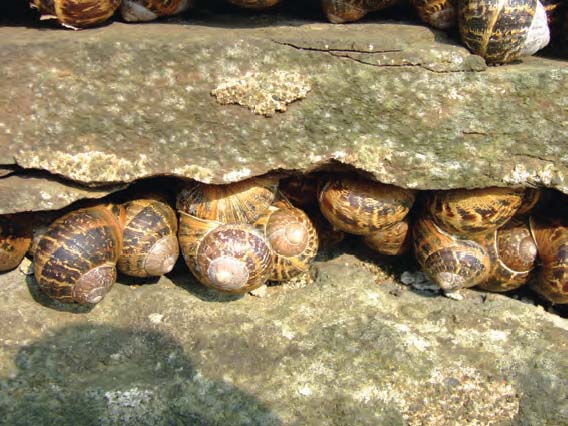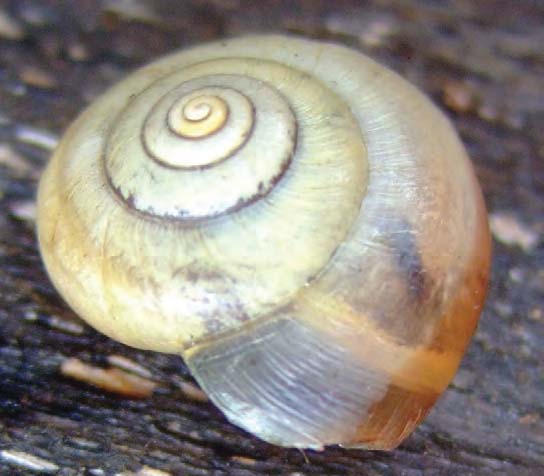Issue
17
Page
25
|
It may have been the wet weather. It may have been because my wife retired and we had the opportunity to travel more. It may just have been chance. Whatever the reason, 2007 turned out to be a particularly good year for finding freshwater and terrestrial molluscs in Scotland.
It started in January, only a few hundred yards from home in North Berwick, just over 20 miles east of Edinburgh. The North Berwick doocot (dovecote in plain English) (Fig. 1) is surrounded by a small wooded area which, although used as a racetrack by local youths, nevertheless still has quite an abundant fauna. A few years ago, Chris du Feu showed me some specimens of the “greenhouse” slug Lehmannia valentiana (Fig. 2) from Edinburgh, and back in 2005 I had found a slug that I thought looked like this species. However, Geraldine Holyoak, then Non-Marine Recorder, could not be certain as it was too immature. There was, however, no doubt about the specimen I found in January 2007, which was confirmed by Adrian Norris. The species can still be found there regularly, and by the end of the year it had turned up in my garden. Lehmannia valentiana also turned out to be very widespread in the City of Edinburgh, and in addition was present in Peebles, some 24 miles to the south.
Business took me up to Aberdeen in late March, and I used the opportunity to travel up there early and go beyond Aberdeen to the small towns of Huntly, Insch and Inverurie, on the railway to Inverness. These all seemed to be under-recorded areas, but I was lucky to find fairly rich sites at each place (where I only had an hour or two to spare), and came away with some good lists of molluscs. Particularly noteworthy were Limax maculatus at both Huntly and Insch, a very long way from the nearest place where they have been recorded previously, and Helix aspersa clustered in cracks in a wall at Insch (Fig. 3), a long way inland from the coastal sites that it prefers so far north (see Kerney, M.P. 1999 Atlas of the Land and Freshwater Molluscs of Britain and Ireland. Harley Books, Colchester; this is referred to below simply as Atlas). Both sites for Limax maculatus were disturbed habitats, so the slugs could well have been recently introduced, but as so often happens with this species, they were quite numerous, especially at Insch.
A week’s break in May took us down to Galloway, in south-west Scotland, and it turned out to be quite easy to find plenty of new records in this poorly recorded area. Species such as Arion flagellus and Arion owenii were widespread, and Limax maculatus and Boettgerilla pallens were also found in a number of places. No doubt they have all been there for a number of years, but too few conchologists visit this beautiful area. Perhaps the highlight of the holiday, however, was finding two species of Oxychilus unusual in Scotland. This was near St Ninian’s Cave on the south coast near Whithorn. St Ninian (circa 360–432) used to retire to the cave to escape from the stresses of monastic life. Now the cave is a popular tourist attraction, but presumably none of the visitors to it realises that the verges of the wooded path leading down to the beach where the cave is are rich in Oxychilus draparnaudi (which has a rather sparse and patchy distribution in Scotland, mainly in the central belt), and the even rarer Oxychilus helveticus (Fig. 4), which is known from only three other places in Scotland.
It is often not necessary to go far to make new discoveries, and in late June, at Aberlady in East Lothian, only a few miles from home, I spotted a snail that had become unfamiliar to me since moving to Scotland nearly 40 years ago. This was a specimen of Monacha cantiana (Fig. 5), new to East Lothian and known from only a few sites in Scotland. The county is known for its dry sunny climate, but it hardly resembles the Mediterranean where this species originally came from!
My wife was keen to see the Scottish Primrose (Primula scotica), which only grows on the north coast of mainland Scotland and in Orkney, so in July we headed north. On the way I found Boettgerilla pallens at Tain in Ross-shire; could this be the furthest north for this species? We stopped for a few nights at Golspie in Sutherland, where I had my first surprise within a few minutes of arrival. As we took a walk along the promenade by the sea, I only just avoided treading on a specimen of Monacha cantiana – thirty-eight years in Scotland without seeing one, and then two sightings within a few weeks! There was apparently a flourishing population of this species, at a place even less Mediterranean than East Lothian. Although the east coast of Sutherland is quite dry, it can certainly suffer from cold easterly winds. There appears to be an interesting story about this population that I hope to be able to tell some time. Incidentally, it is not in quite the same spot as shown in the Atlas. Just south of the village of Golspie, Balblair Wood, the most northerly pinewood in Scotland, yielded a specimen of the calcifuge snail Zonitoides excavatus, rare on the east coast, but little else. Pine woods are rather an acid environment, and generally have a poor molluscan fauna.
A few miles south of Golspie, at Dornoch, there is still a thriving but somewhat isolated population of Cernuella virgata. This species was common on the sand dunes, but also occurred on the saltmarshes, where it was mixed up with huge numbers of shells of Myosotella myosotis, no doubt washed up by winter storms – a surprising combination of species. However, it was in the beautiful gorge of the Big Burn in Golspie itself (Fig. 6) that I had my nicest finds. This small area proved to be very rich, even with only a rather cursory examination. The tall railway bridge at the entrance to the gorge carried a large population of Clausilia bidentata, no doubt attracted by the lime in the mortar, and confirming a pre-1965 record in the Atlas. Boettgerilla pallens was soon discovered as well – Tain was evidently not its furthest north! Further up the gorge I collected some small shells, thinking they were probably something ordinary, but which turned out when I examined them later to be the rare ancient woodland species Spermodea lamellata and Leiostyla anglica, both present in good numbers; I had previously found only a handful of specimens of the first, while I had never before found specimens of the latter myself.
Pressing on further north, I found the most northerly specimen yet of Boettgerilla pallens at Helmsdale, just south of the border with Caithness.* Caithness, our ultimate destination, was less exciting than east Sutherland, though I was able to confirm the continued presence of Helicella itala on the east coast north of Wick; the 1999 Atlas only shows a pre-1965 record for this area. Although there were some large green slugs in Thurso, when I got some specimens home they turned out to be too poorly preserved or too immature to determine if they were Limax flavus (as shown in the Atlas) or Limax maculatus (which largely seems to have replaced L. flavus in Scotland).
Since discovering in 2002–3 that several freshwater species were much more widespread in the canals of central Scotland than had previously been recorded (Sumner, A.T. 2006 Distribution of certain molluscs in the lowland canals of Scotland. Journal of Conchology, 39: pp. 221–228) I have been monitoring their distribution each year. By 2007 Bithynia leachii had filled almost all the gaps that I found in 2003, and so was present virtually throughout the length of the canals, whereas before 2003 it had been recorded only from a single site. Other species had also extended their ranges, though not so spectacularly. But what of the other Scottish population of Bithynia leachii at Pitlochry shown in the Atlas? The reported site was at Loch Dunmore, an artificial but lovely loch in Faskally Woods to the north of the town (Fig. 7). However, although there were plenty of freshwater molluscs here, there was no sign of Bithynia leachii. On the other hand, the surrounding woods turned out to be a good site for Malacolimax tenellus, normally “difficult to find” according to Michael Kerney (Atlas). Back in the town of Pitlochry, I found Limax maculatus, once again a long way from its previously known haunts.
In early September I needed some specimens of Potamopyrgus antipodarum, and to get to the nearest stream where they lived I took a walk along the beach at North Berwick. I remembered that I’d found some specimens of Candidula gigaxi here a few years ago, and wondered if they were still present. The only reported Scottish population of this snail had last been reported in 1930 from Canty Bay, a couple of miles east of North Berwick. Michael Kerney had asked me to look for it, and in due course I re-found it in 2000, and the North Berwick population proved to be still there in 2007. So how far did this species extend? Aided by the wet autumnal weather in 2007, which made both Candidula intersecta (which is widespread along this coast) and Candidula gigaxi much more active and easy to find, I discovered that Candidula gigaxi extended quite a few miles in both directions from its original site at Canty Bay, and in some places seemed to have displaced Candidula intersecta completely. But yet another surprise was in store! Back in 1999 I had found Cernuella virgata at Longniddry, nearly 10 miles west along the coast from North Berwick, and so far as I knew the only site in the Lothians for this species. But the wet weather had brought it out, and it turned out to be present along many miles of coastline, even in places which I passed regularly, and where I had had no idea of its existence.
So what can be deduced from all this activity? First, that conchology is fun and exciting; there is always a thrill in finding a new species, or a familiar species in an unexpected place, and it can take one to some beautiful places. Secondly, new species can still be found in areas one thinks one knows well. More important, though, is finding how the ranges of various species are extending, and being able to monitor this process. Finally, however much one finds, there is always a lot more to be done. 2008 promises to be another busy season!
* This year (2008) I discovered Boettgerilla pallens further north at Dunbeath and Wick in Caithness, but not in Thurso.
|
 Fig. 1. North Berwick doocot, site where Lehmannia valentiana was found in 2007.
 Fig. 2. Lehmannia valentiana
 Fig. 3. Specimens of Helix aspersa sunning themselves in a crack in a wall at Insch, Aberdeenshire, a surprisingly long way inland so far north.
 Fig. 4. Oxychilus helveticus from St Ninian’s Cave, Galloway
 Fig. 5. Monacha cantiana from Aberlady, East Lothian.
 Fig. 6. The Big Burn waterfall, Golspie, Sutherland, at the head of the gorge that provided several interesting finds.
 Fig. 7. Loch Dunmore, Pitlochry, Perthshire. No Bithynia leachii were found here in 2007.
|
